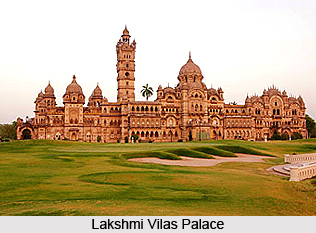 Monuments of Baroda are a legacy of its rich cultural legacy and traditions. Once a princely state of India Baroda or Vadodara, was the capital of the Gaekwad state. The state arose as part of the expansion of Maratha power in the 18th century and the family name `Gaekwad` means literally `Protector of Cows`, a title of religious merit. The monuments and other historical findings of Baroda date it back to the ninth century. It was then a small town called Ankottaka, situated along the bank of the river Vishvamitri. Baroda continued to be in the hands of the Gaekwads from 1734 to 1949, except for a short period of time in 1732 when it was captured by the rulers of the Mughal dynasty. The city saw immense progress under Sayajirao Gaekwad, who made it a centre of art and culture.
Monuments of Baroda are a legacy of its rich cultural legacy and traditions. Once a princely state of India Baroda or Vadodara, was the capital of the Gaekwad state. The state arose as part of the expansion of Maratha power in the 18th century and the family name `Gaekwad` means literally `Protector of Cows`, a title of religious merit. The monuments and other historical findings of Baroda date it back to the ninth century. It was then a small town called Ankottaka, situated along the bank of the river Vishvamitri. Baroda continued to be in the hands of the Gaekwads from 1734 to 1949, except for a short period of time in 1732 when it was captured by the rulers of the Mughal dynasty. The city saw immense progress under Sayajirao Gaekwad, who made it a centre of art and culture.
Baroda is prosperous, neat and well maintained, with broad tree-lined avenues, extensive parks and numerous buildings of considerable distinction, including various exceptional museums and art galleries. A number of monuments, both historical and religious, are found at Baroda.
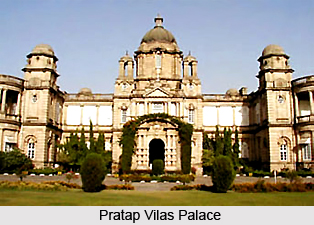 The Lakshmi Vilas Palace is reputedly the most expensive building constructed by an individual in the nineteenth century. It was designed initially by Major Mant, but was completed by Robert Fellowes Chisholm after Mant death. Judging by the febrile eclecticism of the design, it is hardly surprising. The building is a romantic confection of Rajput and Mughal forms, Jain domes, Gothic and classical sources and Hindu martial architecture. It has a spectacular silhouette of enormous power with a central cupola and tall tower. The skyline is a riot of ornamental forms and detail. The entrance to the park is through a handsome gateway, which whets the appetite for the architectural feast to follow. The palace is faced in red sandstone from Agra, with dressings of blue trapstone from Pune and marble from Rajasthan. The interior is equally spectacular. The huge Durbar Hall has a floor of Venetian mosaic, with Italian marble employed throughout. The stained glass is by Dix of London, the staircase figures by an Italian sculptor and the gardens by an expert from Kew. The rooms are appointed in a sumptuous manner with beautiful fittings, armour and 18th-century furniture.
The Lakshmi Vilas Palace is reputedly the most expensive building constructed by an individual in the nineteenth century. It was designed initially by Major Mant, but was completed by Robert Fellowes Chisholm after Mant death. Judging by the febrile eclecticism of the design, it is hardly surprising. The building is a romantic confection of Rajput and Mughal forms, Jain domes, Gothic and classical sources and Hindu martial architecture. It has a spectacular silhouette of enormous power with a central cupola and tall tower. The skyline is a riot of ornamental forms and detail. The entrance to the park is through a handsome gateway, which whets the appetite for the architectural feast to follow. The palace is faced in red sandstone from Agra, with dressings of blue trapstone from Pune and marble from Rajasthan. The interior is equally spectacular. The huge Durbar Hall has a floor of Venetian mosaic, with Italian marble employed throughout. The stained glass is by Dix of London, the staircase figures by an Italian sculptor and the gardens by an expert from Kew. The rooms are appointed in a sumptuous manner with beautiful fittings, armour and 18th-century furniture.
South of the railway is the Pratap Vilas Palace built in 1910, is an elegant classical range of two storeys with a rusticated base, comer quoins and semicircular bays flanking the entrance. The corner towers are capped by shallow domes with circular windows in a faintly Arts and Crafts style. The Palace once functioned as the residence of the royal family. It has now been converted into the Railway Staff College.
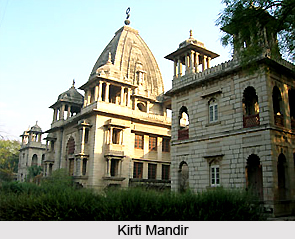 The Makarpura Palace is situated beyond the military parade grounds, 4 miles south of the city. It has been constructed in the Italian Renaissance style. It has a main facade of three storeys, each arcaded with semicircular arches, crowned by a balustraded parapet and shallow urns. Only the full-blooded Bengali-style curved roof over the side entrance porch and the shallow dome over the tower betray the Oriental context. The gardens are stunning. There is a splendid summerhouse of painted trellis-work embellished with domes and covered in creepers, plants and shrubs. The Palace is now used as an Indian Air Force training school. About 150 ft north of the Makarpura Palace is the Naulakhi Well, a well-preserved structure of the baoli type containing galleried apartments and covered with an aluminium roof, a development unique to Gujarat.
The Makarpura Palace is situated beyond the military parade grounds, 4 miles south of the city. It has been constructed in the Italian Renaissance style. It has a main facade of three storeys, each arcaded with semicircular arches, crowned by a balustraded parapet and shallow urns. Only the full-blooded Bengali-style curved roof over the side entrance porch and the shallow dome over the tower betray the Oriental context. The gardens are stunning. There is a splendid summerhouse of painted trellis-work embellished with domes and covered in creepers, plants and shrubs. The Palace is now used as an Indian Air Force training school. About 150 ft north of the Makarpura Palace is the Naulakhi Well, a well-preserved structure of the baoli type containing galleried apartments and covered with an aluminium roof, a development unique to Gujarat.
The Nazarbagh Palace lies almost at the centre of town. Built in 1721, it is a three-storey pile with arcaded verandas in Corinthian style, with a cresting of `pic-crust` parapets. A solid gold and solid silver gun are kept here, the former weighing over 127 kg (280 lb), drawn on ceremonial occasions by a team of white bullocks. It now houses the royal family heirlooms.
Museums housing ancient artefacts are also found at Baroda. The Museum and Picture Gallery (1894) are contained in the Victoria Diamond Jubilee Institute in the Sayaji Bagh, a pleasant riverside park, at the entrance to which is a large bronze equestrian statue of His Highness Maharaja Sayaji Rao III. The Museum pavilion, designed by the Chennai architect Robert Fellowes Chisholm (1840-1915), contains a section on Industrial Arts. The Art Gallery has a collection of Mughal miniatures and European masters. A modern planetarium stands nearby. Within the park, which is a relaxing retreat, are a zoo, miniature railway and an equestrian statue of Chhatrapati Shivaji, the Maratha warrior-prince. Between the park and the Kirti Mandir is a 16th century bridge, one of four over the Vishvamitri River.
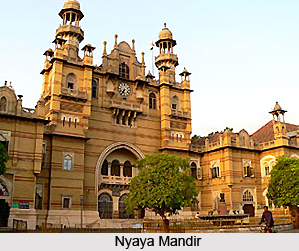 Lying immediately to the South of the Lakshmi Vilas Palace is the Maharaja Fateh Singh Museum. It houses some of the state collection of European art, including works by Murillo, Titian and Raphael, as well as Chinese, Japanese and Indian exhibits.
Lying immediately to the South of the Lakshmi Vilas Palace is the Maharaja Fateh Singh Museum. It houses some of the state collection of European art, including works by Murillo, Titian and Raphael, as well as Chinese, Japanese and Indian exhibits.
The religious monuments of Baroda mainly comprise Hindu places of worship. The Kirti Mandir or Temple of Fame is the Gaekwad family burial ground, containing the cenotaphs of previous rulers. It was built sometime in the early 20th century, commissioned by Maharaja Sayaji Rao. The term Kirti Mandir literally means Hall of fame. It is a stone building designed in the Hindu style with complete with terraces, domes, balconies as well as a central shikhara. The vault is decorated with murals made by the Indian artist Nandalal Bose. There are a cluster of Lord Shiva temples built around here.
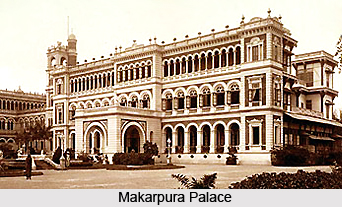 The EME temple has been built at Baroda in reverence to Lord Dakshinamurthy, one of the reincarnations of Lord Shiva. The temple has been constructed out of aluminum and some alloys. There are a number of ancient statues in the temple, dating back to almost the 6th century. These have been beautifully aligned along the path of the temple.
The EME temple has been built at Baroda in reverence to Lord Dakshinamurthy, one of the reincarnations of Lord Shiva. The temple has been constructed out of aluminum and some alloys. There are a number of ancient statues in the temple, dating back to almost the 6th century. These have been beautifully aligned along the path of the temple.
Among Muslim religious monuments, the Maqbara or Hajira is the only Mughal monuments of the city. It was built in memory of Qutub-ud-din, a general of Akbar`s army.
A number of architectural constructions are found here, which, though used for civic purposes are of great historic interest due to their colonial construction.
The Kothi building, now housing the Secretatriat is a late 19th century construction. This resembles an English college, with mullioned and transomed windows and a central hall with traceried windows crowned by a fleche spire. Adjoining the Sursagar Tank is the Nyaya Mandir (1896), the High Court, an interesting commingling of Mughal and Gothic styles. The City Library (1876) is also by Major Mant. The centre of the old city is a marketplace marked by the Mandvi, a square Muslim pavilion (1736) and clocktower. The Shri Sayaji General Hospital (1876), designed by Major Mant (1840-81), a pioneer of Indo-Saracenic architecture in India.
The Kalabahavan Technical Institute (1922) is a fine Indo-Saracenic pile with a high central tower and dome in polychromatic stonework, continuing a tradition established by Mant and Chisholm over forty years earlier. To the north of the city are the Cantonment and Residency. The Anglican Church was consecrated by Bishop Heber in 1825, but was rebuilt thirteen years later.



















